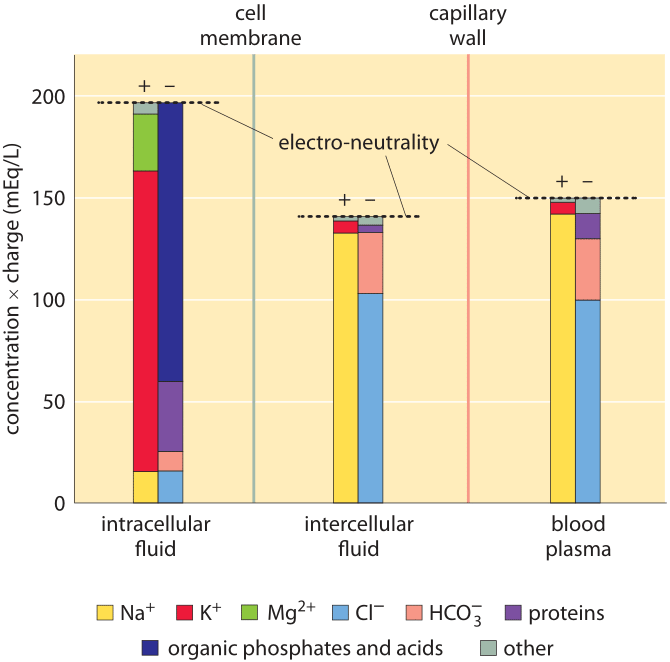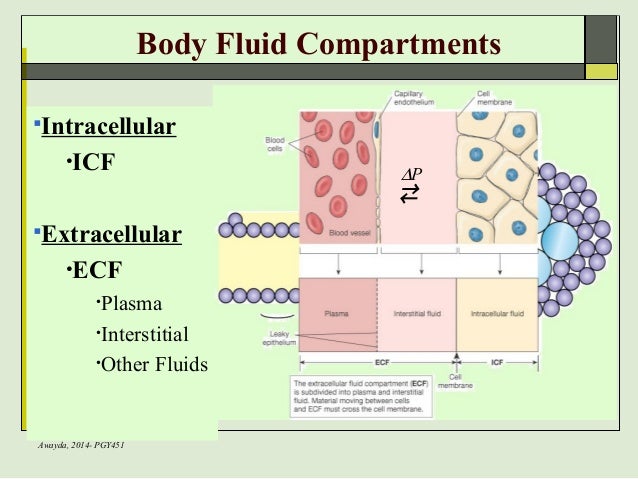
Water and electrolytes are continuously moving across barriers (eg, cell membranes, vessel walls), albeit often in small amounts, to maintain this healthy balance. The normal processes by which life self-regulates its biochemistry ( homeostasis) produce fluid balance across the fluid compartments. The extracellular fluids may be divided into three types: interstitial fluid in the "interstitial compartment" (surrounding tissue cells and bathing them in a solution of nutrients and other chemicals), blood plasma and lymph in the "intravascular compartment" (inside the blood vessels and lymphatic vessels), and small amounts of transcellular fluid such as ocular and cerebrospinal fluids in the "transcellular compartment". Ībout two-thirds of the total body water of humans is held in the cells, mostly in the cytosol, and the remainder is found in the extracellular compartment. The intracellular compartment is the space within the organism's cells it is separated from the extracellular compartment by cell membranes. The two main fluid compartments are the intracellular and extracellular compartments.

The human body and even its individual body fluids may be conceptually divided into various fluid compartments, which, although not literally anatomic compartments, do represent a real division in terms of how portions of the body's water, solutes, and suspended elements are segregated. For the concept of informal shared public space in community planning, see Third place. For the postcolonial term, see Third Space Theory. The fact that we see a lot of Ca and HCO3 is because Ca(HCO 3) 2 is bicarbonate."Third space" redirects here. The fact that we see a lot of Na and Cl is because that’s salt. Proteins in general have a weak negative polarity. Protein – (due to negatively charged amino acids in proteins) This chart says ICF AND EXF and lists the electrolytes found most often. There are very important differences between the electrolytes inside and outside the cell which we will talk about in detail in the future. How much blood would you have to have to have lost for them to do an IV drip? You would have had to lose more than a liter of your blood volume, which is about 20% of your blood. Then they tell you to drink some orange juice, eat a cookie and you’ll be okay. If you go to donate blood, they take about a 1/10th of a liter of blood. So our reference person has 0.08 x 70kg = 5.6kg = 5.6L of blood. Remember, we can calculate volume from mass without a problem because that’s the beauty of the metric system (1.0kg water = 1.0L water) Total Blood Volume (TBV)īlood is made up of blood cells and blood plasma. Ascites is the buildup of the peritoneal fluid (abdominal edema). Hydrocephalus is when too much fluid from the blood stream is building up in the CSF. If you injure your knee, fluid starts to flow from your blood stream into the sinovial fluid and starts to build up. The fluid inside your eyeball is intraocular fluid (sometimes called vitreous humour). We also have slippery serous fluids in our abdominal and chest cavities, known as peritoneal fluid and pleural fluid, respectively. Sinovial fluids are the slippery fluids contained within the sinovial joints such as the knee, elbow, and between the tibia and femur. For example, CSF surrounds your brain and spinal cord and it’s contained in your skull and your spinal column. Transcellular fluids are ECF that are contained in specific anatomical areas of the body, within epithelial lined spaces. Transcellular fluid: Often not calculated as a fraction of the extracellular fluid, but it is about 2.5% of TBW.

Now to make things slightly more complicated, there’s really three types of ECF: E comes before I in the alphabet, so E is 1/3rd and I is 2/3rd. Mnemonic to help you remember which is 1/3rd and 2/3rd: ECF and ICF.

ECF is also known as interstitial fluid because it’s the fluid in between the cells. Intracellular Fluid (ICF): The amount of water that’s inside our cells accounts for 2/3rds of our TBW.Įxtracellular Fluid (ECF): The amount of water that surrounds our cells accounts for 1/3 of our TBW. TBW: 0.6 x 68.9kg is 41kg which means we have 41L TBW. So anyway, the answer is very close to that. If we divide 2 into 150, that would be 75kg. Normally you would have used your calculator to do this but I beg you estimate what the right number should be. Why is body weight expressed in kilograms? Because the metric system is very clever: One liter of fluid weighs one kilogram. The first thing we need to do is convert pounds to kilograms. So, sometimes we need to estimate what is the total amount of water a person is made of. You know water is the major thing that living things are made of and as a nurse, you’re going to need to make sure your patients hydration levels are appropriate.


 0 kommentar(er)
0 kommentar(er)
